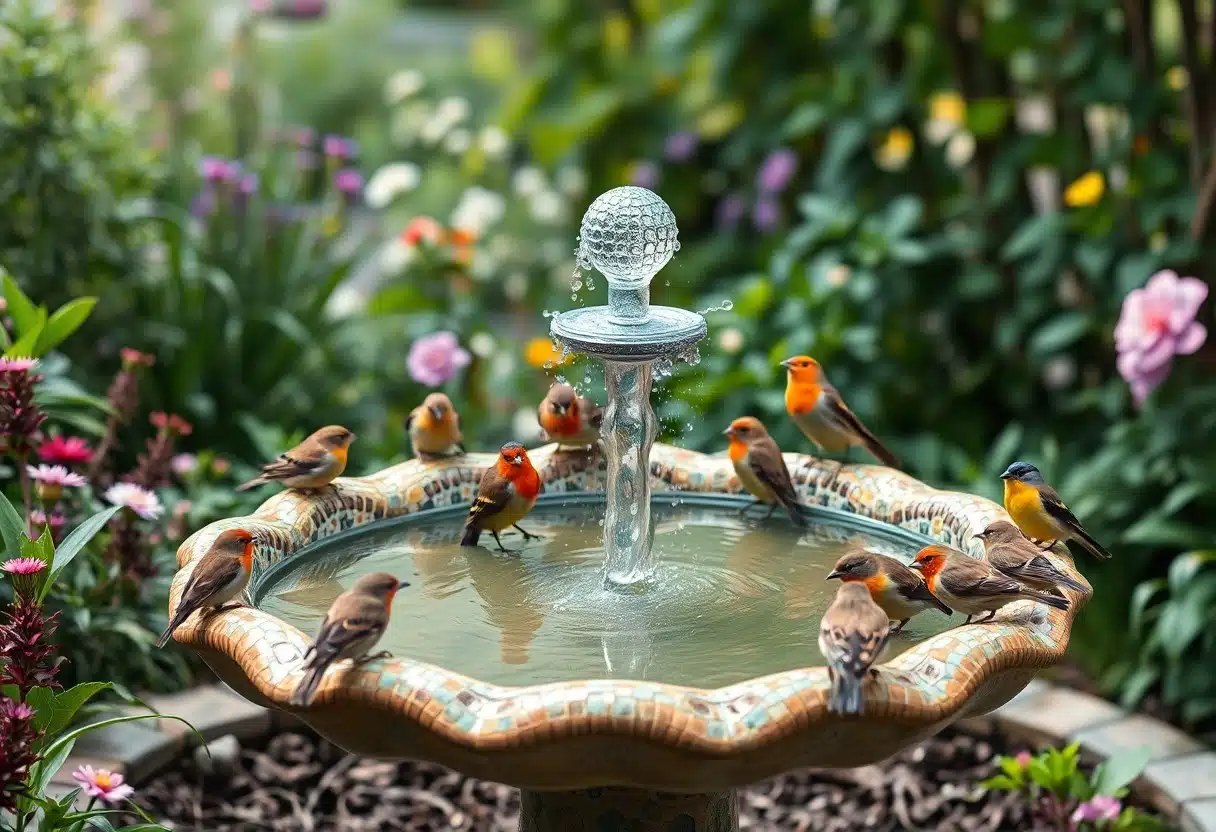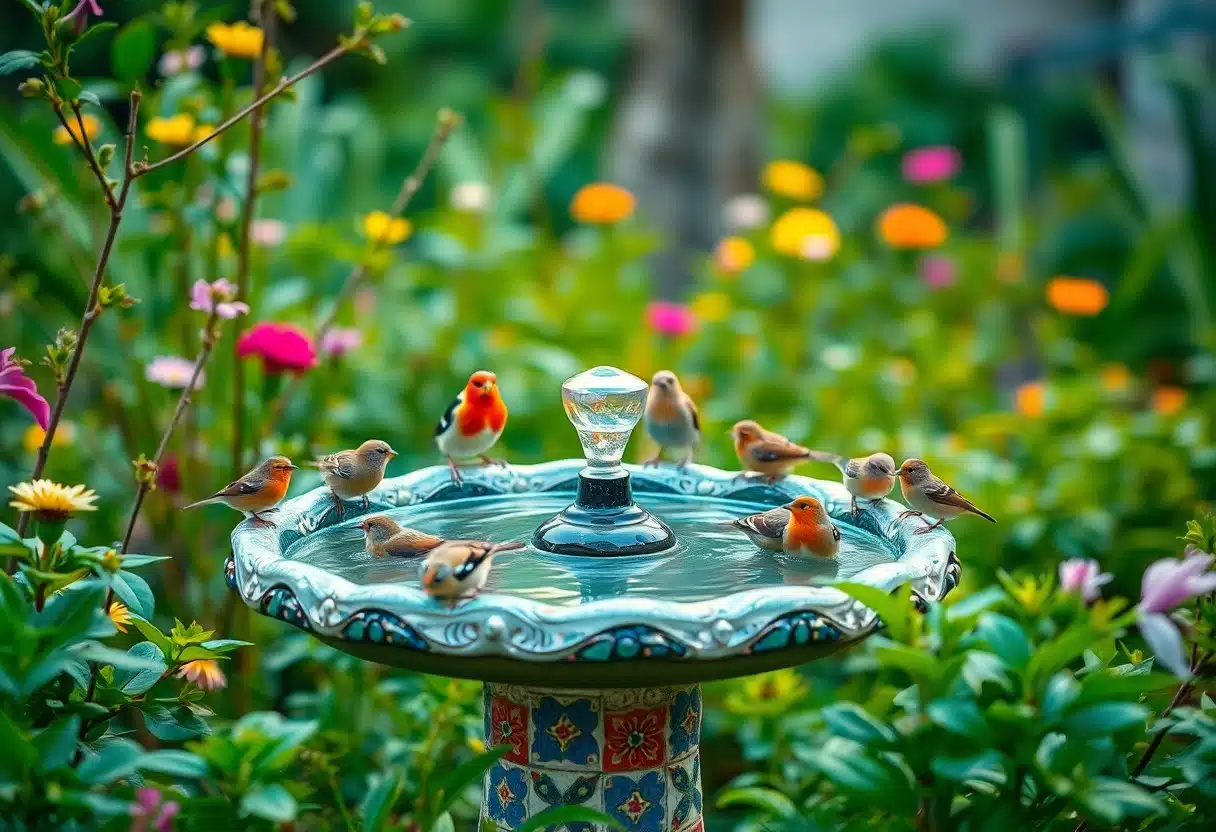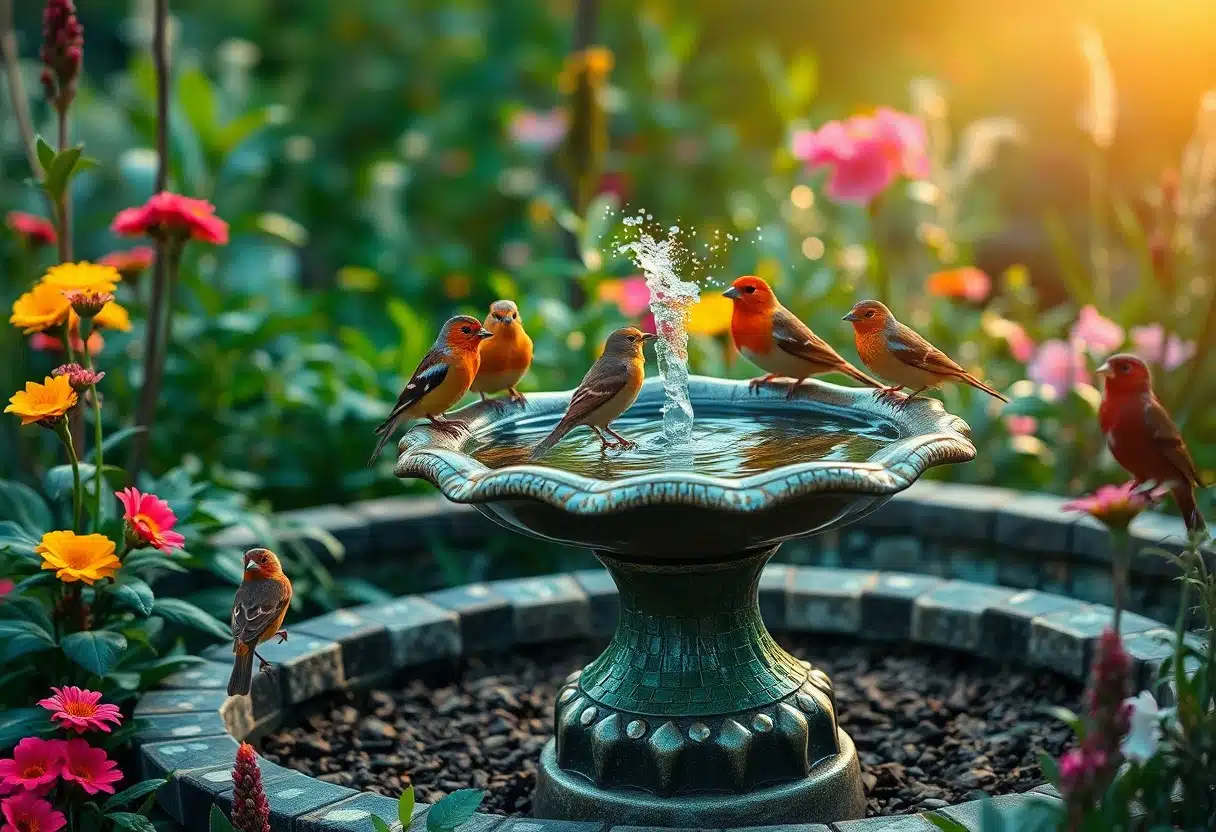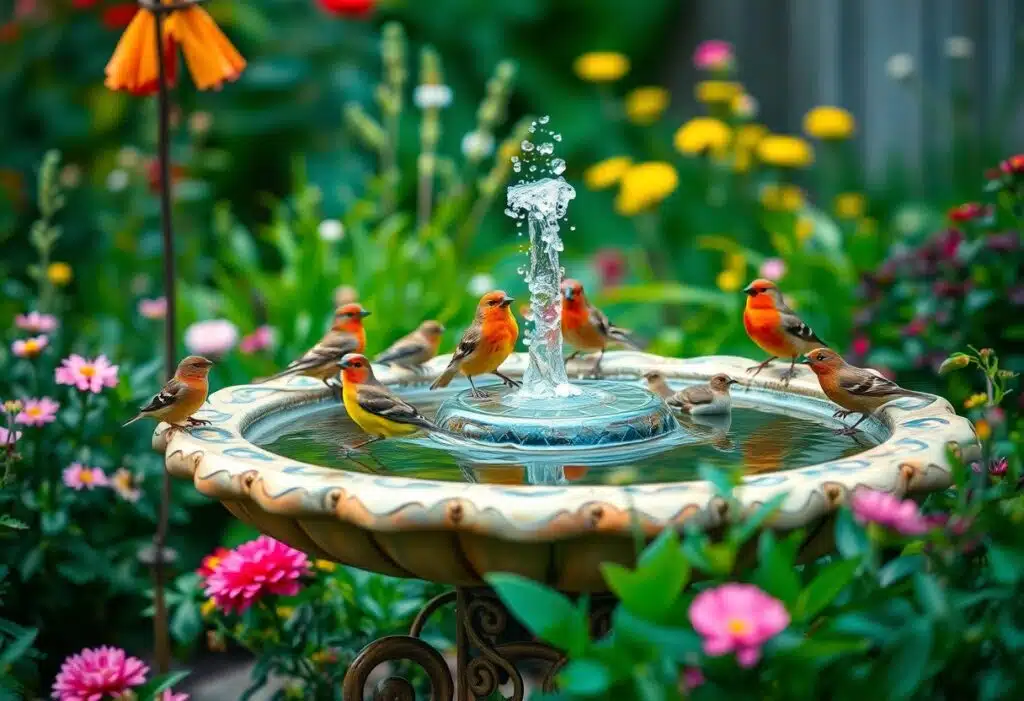Attract Birds to Bathe in Your Backyard: Why Do Birds Like Bird Baths?
Wildlife enthusiasts often wonder why Birds seem to prefer areas where they can easily find water. are so attracted to bird baths. These charming water features provide vital benefits that help birds stay healthy and comfortable. Your backyard can become an irresistible haven for feathered friends when you create an inviting environment. Birds need clean water not only to bathe but also to stay cool, preen their feathers, and hydrate. In this guide, you’ll discover how a simple bird bath can transform your space and attract a variety of birds!
Key Takeaways:
- Feather Maintenance: Birds need to keep their feathers clean and waterproof. A good bath helps them wash away dirt and parasites. After bathing, they preen to realign the tiny barbs on their feathers, making them ready for flight.
- Cooling Down: On hot days, birds can’t sweat like us. They use bird baths to cool off and enjoy bird bathing. The water evaporates from their feathers, helping them stay comfortable.
- Socializing: Bird baths act as social spots. Many birds enjoy bathing together, allowing them to form bonds and interact, making your backyard lively with feathered friends.
> Providing a birdbath with clean water not only offers a place for birds to bathe but also attracts a variety of bird species to your backyard. Never underestimate the power of a birdbath! Keeping your birdbath clean and in a good spot can turn your yard into a favorite hangout for feathered visitors. Just like us, birds need places that feel good and work well for their needs. So, ensure your birdbath is a lovely, inviting space for them!

Types of Bird Baths
The right type of bird bath can make a big difference in attracting various birds to your yard. Here are some popular styles:
| Type | Description |
|---|---|
| Ground-level Bird Baths | Shallow, easy access for birds to bathe and drink. |
| Hanging Bird Baths | Suspended from trees or hooks, perfect for smaller birds. |
| Decorative Bird Baths | Beautiful additions that enhance your backyard. |
| Solar Bird Baths | Self-cleaning with circulating water features. |
| Heated Bird Baths | Provide water during colder months for birds. |
The different types of bird baths can attract a wider variety of birds, each providing unique benefits and features.
Ground-level Bird Baths
Groundlevel bird baths are ideally positioned close to the ground. This makes it easy for birds to access the water for both bathing and drinking. They typically have a shallow design, around 2-3 inches deep, allowing even smaller birds to safely use them.
Hanging and Suspended Bird Baths
Assuming you want to add a unique feature to your yard, consider hanging bird baths. These types are suspended from trees or hooks, making them appealing for smaller birds who may feel safer off the ground. They often come with designs that provide easy access and a gentle splash for bird bathing.
Another benefit of hanging bird baths is their ability to minimize disturbances from ground predators. By elevating the water source, you ensure a safer environment for your feathered friends, allowing them to enjoy their baths with less stress.
Decorative and Solar Bird Baths
Bird baths can also be decorative elements in your garden. Choosing solar bird baths not only adds elegance to your backyard but also includes features that help keep the water clean. They utilize solar power to keep water moving, which discourages algae growth and attracts more birds.
With the added benefit of moving water, these solar bird baths can create a visually stunning focal point in your garden. The sight and sound of flowing water can be very appealing to birds, prompting them to visit regularly for baths and drinking.
Heated Bird Baths
Baths designed for winter features are heated to prevent water from freezing. This ensures that your avian visitors have a reliable water source even when temperatures drop below freezing. It’s necessary during colder months, as many birds need water to stay hydrated.
Suspended heated bird baths are particularly effective in colder weather. They provide consistent access to clean and warm water, encouraging birds to linger in your backyard even in the coldest months. With the right setup, you can ensure that your yard is welcoming year-round.
Birds Like Bird

Unique Features That Attract Birds
Not all bird baths are created equal! Unique features can significantly enhance your backyard’s appeal, drawing in a variety of feathered friends. Elements like design, depth, and movement make a big difference in creating an inviting space for birds to bathe, socialize, and cool down. By understanding these features, you can attract even more birds to your backyard sanctuary.
Nature-inspired Designs
One of the best ways to attract birds is through nature-inspired designs. Bird baths that mimic natural features, like rocks or ponds, blend seamlessly into your garden. This helps birds feel safe and encourages them to visit more often, increasing your chances of seeing beautiful species enjoying a refreshing soak.
Multi-tiered Options
On the other hand, multi-tiered bird baths can be incredibly effective. These designs offer various water levels, allowing birds of different sizes to bathe and drink comfortably. Whether it’s a big robin or a tiny finch, everyone has a place at your bird bath buffet!
Plus, having multiple tiers means there are shallow and deep areas for birds to use as they wish. The shallow pools make it easy for smaller birds to wade in safely, while deeper spots can accommodate larger birds that prefer a more substantial bath experience. This variety not only attracts a broader range of bird species but also creates a lively atmosphere where birds can splash around together, enhancing your overall birdwatching experience.
Water Movement Mechanisms
Options like moving water can be game-changers in attracting birds. Features such as misters and Ever wondered why birds are attracted to a dripper in your garden?s simulate the sound of flowing water, encouraging birds to flock to your bath. Moving water stays fresher and discourages algae growth, making it more appealing for birds to bathe and drink.
The gentle sound of dripping or flowing water is not just a nice touch; it actually helps birds locate the water source. Birds like the cooling effect of water in motion, and they may feel safer bathing where they can easily escape potential threats. Installing a small fountain or dripping mechanism can transform your bird bath into a lively, attractive site, guaranteed to fill your backyard with joyful avian visitors!

Tips for Choosing the Right Bird Bath
For creating a relaxing spot for your feathered friends, select a bird bath that meets their needs. Consider these factors:
- Size and Depth: Ensure it’s not too deep for smaller birds.
- Materials: Choose durable options that withstand weather conditions.
- Location: Place it in a spot that’s safe and visible.
- Water Movement: Incorporate a fountain or mister to keep water fresh.
Assume that with the right bird bath, your yard will become a popular stop for birds!
Size and Depth Considerations
If you want to attract a variety of birds, the size and depth of your bird bath matter. Aim for a depth of 2-3 inches, which allows birds to bathe comfortably without risking drowning. Shallow basins are perfect for smaller birds, helping them feel safe as they splash around and enjoy their bath.
Materials and Durability
While choosing materials for your bird bath, opt for options that can weather outdoor elements. Durable materials will stand up to sun, rain, and freezing temperatures, ensuring your bird bath lasts long. Look for ceramic, stone, or high-quality plastic that won’t crack easily.
For instance, ceramic birdbaths are often elegant and sturdy but can be heavy and prone to breakage. Stone bird baths provide excellent durability but can be costly and immobile. Plastic options are lightweight and won’t break, but ensure they are thick and UV-resistant to last longer. A combination of materials may be the best option to balance aesthetics and durability.
Location and Accessibility
Assuming you want your avian visitors to feel secure, place the bird bath in a clear area where birds can see any potential dangers. Avoid spots too close to dense shrubs or trees where predators might lurk. A good location allows for easy access to water and a safe environment for bathing.
Accessibility is crucial for both the birds and you. Position your bird bath where you can enjoy watching the action while keeping it easy for birds to visit. Consider adding elements like rocks or shallow sections to help birds feel safe while they bathe. Keeping the bath visible will also enhance your experience watching them splash around.
Step-by-Step Guide to Installing a Bird Bath
Many people love to attract birds to their backyard with a bird bath. It’s an excellent way to provide a clean water source for them to bathe and drink. To get started, check out these Here are 11 best bird baths for your backyard bird garden.. Follow these simple steps to create a welcoming spot for your feathered friends.
| Step | Action |
|---|---|
| 1 | Select the Optimal Location |
| 2 | Prepare the Site |
| 3 | Positioning and Anchoring |
Selecting the Optimal Location
To create a perfect spot for your bird bath, look for a sunny area near shrubs or trees. Birds prefer safe places where they can quickly escape from predators. Placing your bath close to a bird feeder can also help attract more avian visitors.
Preparing the Site
If the ground is uneven or muddy, clear the area where you want to set up your bird bath. Leveling the ground ensures stability, so your bath doesn’t tip or wobble when birds come to bathe.
Plus, adding a layer of sand or gravel beneath your bird bath can help with drainage and keep it steady. Aim for a clean, stable surface that makes it easy for birds to use the bath. This will allow birds to come and go comfortably while keeping water where it belongs.
Positioning and Anchoring
For the best results, place your bird bath in a way that is easy for birds to see and access. Keep the height around 2-3 inches deep so smaller birds can comfortably wade in. You can also use stakes or bricks to anchor your bath if it’s top-heavy.
Bathing birds feel safe knowing they can easily flee if needed. Ensuring your bird bath has a good, secure stance is key. This setup will help keep the water clean and allow birds to take a bath without worry.
Factors Influencing Bird Bath Usage
All bird baths attract a variety of birds based on several key factors, including the presence of water fountains.
- Water Quality
- Freshness
- Surrounding Landscape
- Seasonal Considerations
Knowing these elements can help you create a more inviting space for your feathered friends.
Water Quality and Freshness
An crucial aspect of bird baths is the quality and freshness of the water. Stagnant or dirty water can deter birds from bathing. To keep your bird bath inviting, ensure that you change the water regularly, ideally every few days, and clean the bath to remove any debris or algae. This helps keep the bath safe and encourages your feathered visitors to enjoy a refreshing dip.
Surrounding Landscape and Plants
There’s much more to attracting birds than just having a bird bath. The surrounding landscape and plants can greatly influence which birds visit your yard. Native plants that provide food and shelter will encourage more birds to bathe. Additionally, placing your birdbath near bushes or trees gives birds a resting spot to feel safe.
This way, you create a welcoming environment where birds can find a water source and feel secure. The right mix of plants and landscape features can spur many different species to your backyard, resulting in delightful birdwatching experiences.
Seasonal Considerations
The changing seasons can also impact bird bath usage. In hot summer months, birds may need a reliable source of water features such as bird baths to cool down and hydrate. During winter, you may need to provide a heated solution to prevent the water from freezing, ensuring birds have access even when the temperature drops.
With these seasonal needs in mind, consider adding features like heaters for colder months and making sure your bird bath is easy to access during warm weather. This will help maintain a steady flow of feathered visitors year-round and keep them comfortable in extreme temperatures.
Pros and Cons of Different Bird Bath Styles
Unlike what you might think, not all bird baths are created equal. Each style offers unique benefits and drawbacks for attracting your feathered friends. Understanding these can help you choose the best option for your backyard.
Pros and Cons of Popular Bird Bath Styles
| Style | Pros and Cons |
|---|---|
| Classic Bird Bath | Easy to clean; stationary, but may attract fewer birds. |
| Fountain Bird Bath | Moving water attracts more birds; requires maintenance. |
| Heated Bird Bath | Provides water in winter; needs electricity. |
| Shallow dishes are essential for backyard birds to find water easily. | Great for smaller birds; needs frequent cleaning. |
| Misters | Offers cooling effect; might not suit all bird species. |
| Wall-Mounted Baths | Saves space; may limit bird access. |
| Drippers | Fresh water flow; can be complex to set up. |
| Solar-Powered Features | Eco-friendly; dependent on sunlight availability. |
| Plastic vs. Stone | Plastic is lightweight and affordable; stone looks natural but heavy. |
| Colored Bird Baths | Attractive to humans; colors may not appeal to birds. |
Advantages of Each Type
Cons of different bird bath styles can actually highlight their advantages. For instance, fountain bird baths create moving water that helps to attract a wide variety of birds. Classic bird baths, while static, provide an easy, accessible water source. Heated bird baths ensure that birds have important water even in freezing temperatures, while shallow dishes are perfect for smaller birds looking for a quick drink or bath. Each option brings something valuable to your backyard, making it easier for birds to hydrate and stay cool.
Disadvantages to Consider
Type can often determine the challenges you might face. For example, while heated bird baths are excellent in winter, they require an electricity source. Misters offer a refreshing way for birds to cool off but may not attract all species. Frequent cleaning is necessary for shallow dishes and classic bird baths due to algae growth. Each style may have limitations, so finding the right balance that suits your backyard is crucial.
To keep your bird bath effective, think about the water source. Adding a dripper or fountain ensures moving water, which will naturally stay fresher and help attract more birds. You should also aim for a shallow depth of 2-3 inches; this enables smaller birds to bathe comfortably. Staying aware of algae growth by changing the water frequently will provide a safe bathing spot for your feathered friends.
To Wrap Up
Upon reflecting, it becomes clear why birds enjoy bird baths so much. These water features provide much more than just a place to splash around. They help birds keep their feathers clean and waterproof, cool off on hot days, and even socialize with one another. A well-maintained bird bath can attract a variety of birds to your backyard, allowing you to witness their delightful behaviors. By regularly changing the water and keeping the bath clean, you’ll create an inviting space where your feathered friends can thrive.
FAQ
Q: Why do birds like bird baths?
A: Birds like bird baths because they help keep their feathers clean, cool down on hot days, and even socialize with other birds. It’s a perfect spot for bathing and drinking!
Q: What features should I include in my bird bath to attract more birds?
A: To attract more birds, use a shallow bowl that’s about 2-3 inches deep and consider adding moving water features, like a mister or small fountain. Birds are drawn to fresh, flowing water!
Q: How often should I change the water in my bird bath?
A: You should change the water in your bird bath at least once a week, or more often if it’s hot outside. Keeping it clean helps prevent algae and provides a healthy spot for birds to bathe and hydrate.
As a bird enthusiast with a passion for sharing the wonders of our feathered friends. As a writer and nature lover, I'm thrilled to connect with fellow bird buffs and inspire others to take flight into the fascinating world of birds. Let's wing it together!


